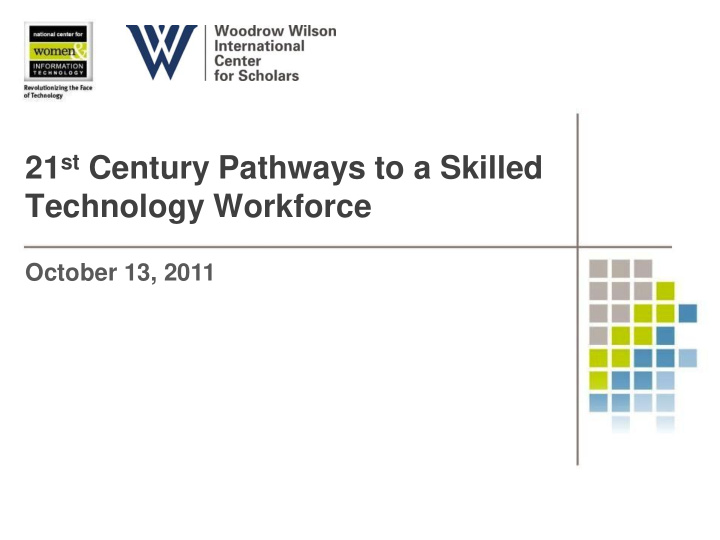



21 st Century Pathways to a Skilled Technology Workforce October 13, 2011
Agenda 8:00 AM: Registration & Continental Breakfast 8:30 AM: Opening Remarks 9:45 AM: Keynote Addresses 9:30 AM: Panel 1: STEM and the Search for Technical Talent 10:30 AM: Coffee & Conversation 10:45 AM: Panel 2: National Security & the US Technical Workforce Panel 3: Approaches for Creating a Skilled 11:45 AM: Technology Workforce 12:45 PM: Closing Remarks
Opening Remarks » Kent Hughes: Director, Program on America and the Global Economy, Woodrow Wilson Center » Lucinda Sanders: CEO & Co-founder, National Center for Women & Information Technology (NCWIT)
New Job Classifications Emerging Source: Wired Magazine and LinkedIn – June 2011
Today, “Smart Jobs” = Post -Secondary Education Percentage of STEM workers with a 68% bachelor’s degree or higher Percentage of STEM workers with 23% an associate’s degree Percentage of STEM workers with 9% high school or less Source: “STEM: Good Jobs Now and For the Future”, U.S. Department of Commerce
Traditional “Non - STEM” Jobs Now Require More Technical Skills Percent of non-STEM workers today 40% have a high school education or less Source: “STEM: Good Jobs Now and For the Future”, U.S. Department of Commerce
An Example - The Computing Sector Number of computing/technology 1.4M job openings the U.S. Dept. of Labor estimates will be available by 2018 Portion of these jobs that can be 29% filled with graduates of U.S. computing degree programs Source: NCWIT and US Bureau of Labor Statistics
US K-12 Computing Education Pipeline is Eroding Two-thirds of states teach computing literacy (word processing) instead of fluency (computing concepts). Only 9 states allow computing courses to count towards high school math or science requirements for graduation. Girls comprise 46% of Advanced Placement (AP) Calculus test-takers, but only 19% of AP Computer Science test- takers. Source: ACM and CSTA, “Running on Empty”
Matching Computing Jobs, Education www.ncwit.org/edjobsmap
What’s the Story Where You Live? Virginia District 10
Keynote Addresses
Panel 1: STEM & the Search for Technical Talent » Avis Yates Rivers: President & CEO, Technology Concepts Group, Inc. » Donagh Herlihy: Senior VP & CIO, Avon Products, Inc. » Dr. Anthony Carnevale: Director, Georgetown University Center on Education and the Workforce » Cordell Carter: Director of Public Policy, Business Roundtable » Dan Zelem: CIO, Medco Health Solutions, Inc.
Defense Secretary Robert Gates has stated that the Pentagon is “desperately short of people who have capabilities (defensive and offensive cyber-security war skills) in all the serves and we have to address it.” Cyber-Insecurity, Booz Allen Hamilton and Partnership for Public Service
Panel 2: National Security Kelly Carnes: President & CEO, TechVision21 » Laura Adolfie: Director, STEM Development Office, » Department of Defense Susan Lavrakas: Director, Workforce, Aerospace Industries » Association Matt Fussa: Managing Attorney for Global Government » Solutions, Cisco Systems, Inc. Robin Williams: Director, National Cybersecurity Education » & Workforce Development Office, Department of Homeland Security
Panel 3: Creative Approaches » Bill Kamela: Senior Director for Education and Workforce Law and Corporate Affairs, Microsoft » Daphine Kis: IT Advisor, National Academy Foundation (NAF) » Sara Akbar: Senior Manager, Government Affairs, Oracle Corporation » Bob Baugh: Executive Director, AFL-CIO Industrial Union Council
Closing Remarks » Kent Hughes: Director, Program on America and the Global Economy, Woodrow Wilson Center » Lucinda Sanders: CEO & Co-founder, National Center for Women & Information Technology (NCWIT)
Multiple Pathways, Multiple Careers Source: NCWIT Community College and Military Pathways Cards
Matching Computing Jobs, Education www.ncwit.org/edjobsmap
Recommend
More recommend